October 1942 (2)
11-25 October – [continued from October 1942 (1) post] – Henderson Field, on Guadalcanal, received heavy bombardment from two Japanese battleships, the Kongo and Haruna. The US gun batteries damaged 2 of the enemy battleships in the area.
On the 12th, the US Army’s Americal troops arrived and received their baptism under fire rather quickly that night. The SeaBees went into round-the-clock action to fill the airstrip’s craters created by the enemy’s mortars, that the Marines called “Pistol Petes.” The barrage seemed endless with man-sized projectiles flying through the air causing the sound of screeching railroad cars. Gen. Geiger’s pilots began taking fuel from damaged planes as the Cactus Air Force became shred to pieces with the constant action.
18 October – Adm. Halsey, having recovered from his illness, arrived at Noumea to take over command from Ghormley. His orders were waiting for him: “You will take command of the South Pacific area and South Pacific Forces immediately.” Halsey’s first reaction was, “Jesus Christ and Gen. Jackson! This is the hottest potato they ever handed me.” He knew the situation in that vast area of ocean and also that he lacked ships, men and supplies. After his request for all of these were denied, he wrote: “Europe is Washington’s darling, the South Pacific is only a stepchild.” But the news of the admiral’s return gave the men of Guadalcanal renewed hope.
By the 23rd, Henderson Field was attacked by 20,000 enemy troops, under Gen. Maruyama, in their usual wave strategy. For 3 days along the southern positions, at the rivers, wave after wave was defeated until the Japanese had lost about 3,500 men and the offensive collapsed.
24 October – Gen. Marshall ordered MacArthur to get every bomber, in range, to the Solomons – even at the expense of New Guinea. With a stunt learned from an old enemy, LtCol. Chesty Puller and his 1st Battalion hung a barbed-wire perimeter with shell fragments to warn themselves of Japanese infiltrators during the night. Puller was wounded during one of the attacking waves, but remained at the front.
25-26 October – the Japanese Combined Fleet headed to Guadalcanal were met by US Task Forces 16 and 17 near Santa Cruz. The US aircraft failed to find their targets the first day, but the next morning, the opposing aircraft were visible and battled for 4 hours. The Enterprise suffered a smashed flight deck and the Hornet (CV-8) was destroyed by 2 torpedoes and 6 bomb strikes and had to be abandoned. The enemy carriers, Zuiho and Shokaku were not badly damaged, but their loss of 100 pilots and aircraft left them inoperable.
In New Guinea, in an attempt to delay the Australian advance of Kokoda, Gen. Horii directed his retreating battalions to enter Eora Creek ravine in the heart of the Owen Stanley Mts. They climbed to the heights and dug into an elaborate complex of concealed weapon pits; their last line of defense at Oivi on the road from Kokoda to Buna.
28 October – repeated attempts by the Australians to climb up the slopes were met with heavy artillery fire and were thwarted back. Suddenly, the enemy began a fierce bombardment and under the cover of fire and dark of night, Horii withdrew his garrison to Oivi. In 2 months time of the savage struggle at Buna, the Allies lost 3,095 KIZ and 5,451 WIA – an even bloodier struggle than the better-known Guadalcanal.
30 October – the Japanese landed a second invasion force on the island of Attu in the Alaskan Aleutian islands. The naval battles have been on-going since August and would continue until May 1943.
Click on images to enlarge.
##################################################################################
Military Humor – by Sad Sack –
Click on images to enlarge.
##################################################################################
Farewell Salutes –
John Adair Jr. – Jupiter, FL; US Army, Vietnam
Arthur Clarke – Santa Cruz, CA; US Navy, Corpsman (Ret. 29 yrs), WWII, Korea & Vietnam
William Deitz – DE & FL; US Navy, WWII, ETO, LST 656 helmsman
L. Vern Francis – NZ, RNZ Army, WWII, D Company
Jacob Kendall – Ontario & Oregon, US Navy, WWII, ETO
Donald John Nibert – Point Pleasant, WV; US Navy
John Roberts – AUS; RA Air Force # 135801, WWII, PTO, 41st Squadron
Ken Smith – Paeroa, NZ; NZ Army # 444787, WWII, 23rd Battalion, Pvt.
Arnold Stern Sr. – Anniston, AL; US Army (Ret. 23 yrs), WWII, Korea & Vietnam
George Thompson – Broad Channel, NY; US Army, WWII
##################################################################################
Posted on May 4, 2015, in WWII and tagged Alaska, family history, Guadalcanal, History, Military, Military History, New Guinea, Pacific, veterans, WWII. Bookmark the permalink. 44 Comments.

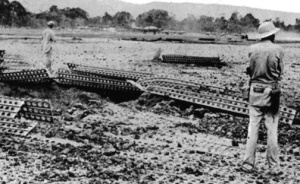
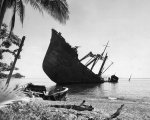
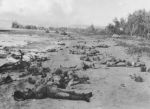
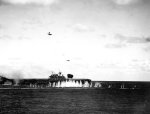
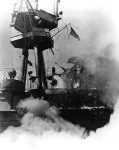
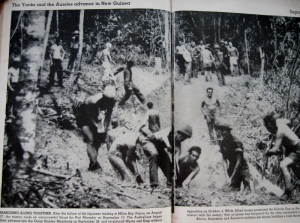
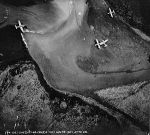









Interesting post. My dad had a book of Sad Sack cartoons. I’ll have to figure out which sister grabbed it.
LikeLike
Let’s hope she still has it!! That would be terrific!
LikeLiked by 1 person
One of the points to come out of your posts gp, is the fact of the works of the engineers during the battles, these guys worked tirelessly and under extreme pressure, especially repairing field strips, these would have been paramount.
Great interesting post mate.
LikeLike
They were everything rolled into one – engineers, soldiers and workers – tough situation to be in.
LikeLiked by 1 person
So many bits of history I’ve never heard. Thanks, GP.
LikeLike
I suppose I shouldn’t be so judgmental of our school systems, as so much was going on all at the same time. I was always disappointed tho that Europe was still being considered the priority subject.
LikeLike
Bless Chesty and the Marine Corps… Guadalacanal was a test for ANY military man – Allied or Japanese. Unbelievable heroism and determination.
LikeLike
Don’t get me wrong, I agree with you – but I always wondered why it took so long, when the Japanese were so outnumbered and out-supplied most of the time.
LikeLiked by 1 person
I feel it’s because they were there for awhile (defensive fortifications) and were quite good at defensive tactics…outside of their senseless banzai charges.
LikeLike
I see. [just to butt in for a sec – I read Beetle in the Palm Beach Post of the Cox Media Group]
LikeLiked by 1 person
See… More pitfalls to living in California! Lol
LikeLike
Ah-ha!! What’s a nice guy like you doing in a state like that?
LikeLiked by 1 person
Sad Sack was still around in the funnies of my day as a child, if I remember correctly.
One of the things that I have learned from your posts, GP, is how much of an unwanted step-child the Pacific war was opposed to the European front when it came to resources. I suspect with the political influence of the Western US that wouldn’t be the case today. –Curt
LikeLiked by 1 person
Yes, Curt, ol’ Sad Sack started in June 1942, written by Sgt. George Baker, appearing in Yank magazine. Later on it was newspaper syndicated in the ’50s.
Pacific was a result of Oriental racism and a friendship between FDR and Churchill, IMO, with the research I’ve done. Just as California’s influential friends urged Washington for the Japanese to be interned was for both racist and monetary reasons. As for the Oregon and Washington state – you would know better than I.
LikeLike
The internment campaign was ugly. There is no other way to describe it. Koji has described the results so well. –Curt
LikeLike
Yes, he has. Koji’s family was was involved in the PTO in so many ways and he has a wonderful writing skill to explain the events to us.
LikeLiked by 1 person
I’m blushing… 🙂
LikeLiked by 1 person
I rushed to read them in the Sunday comics each week… Beetle Bailey, too. Too bad those days are gone, sir.
LikeLiked by 1 person
Well, I still read Beetle Bailey. 🙂
LikeLiked by 1 person
Really? What paper?
LikeLike
Sacramento Bee and my paper in Medford. He’s still outsmarting Sarge. 🙂
LikeLiked by 1 person
Lol!
LikeLiked by 1 person
The battles in the Far East were long and hard. This goes to show how hard. Each island a battle field and the terrors possibly ‘worse’ than in Europe.
LikeLike
Also, one unit couldn’t assist another easily – not with the battlefields hundreds or thousands of miles apart. All in all, I believe the Pacific was a much harder war to fight.
LikeLiked by 1 person
I think you are right. The conditions were more extreme and the terrain a very different kettle of fish altogether. Getting supplies across must have been a logistical nightmare with such distances.
LikeLike
From the mainland, to Hawaii and out…. whoa, that is a lot to think about. Maybe one of us should do a post on those guys.
LikeLiked by 1 person
It’s certainly a big area and a lot of guys to consider, but worthy of a right up.
LikeLiked by 1 person
Interesting post and again something that I didn’t learn in school.
LikeLike
I don’t think many of us did, Kathy. We’re all learning together.
LikeLiked by 1 person
That’s a good thing, Everett! 🙂
LikeLike
Man I always enjoy reading your posts, thank you.
LikeLike
That is a very nice thing to say. I appreciate that very much, Kevin, thank you.
LikeLike
It’s good to see a photo of Aussies and Yanks working together.
LikeLike
They often competed against one another, but they were all there for the same reason.
LikeLike
…and ended up being good mates.
LikeLike
I’ve always heard good things.
LikeLike
PS. There are a couple of questions for an American on my next post. “A sort of a quiz.
LikeLiked by 1 person
One wonder why Buna has not been more prominently mentioned – heard of Guadalcanal many times, but this is the first I have known about those hectic engagements.
LikeLike
Buna was a struggle for the Australians and the US Army – Guadalcanal was the Marines – that calls for more cameramen, color film and more publicity.
LikeLike
That does explain it!
LikeLiked by 1 person
PS. I failed to mention that MacArthur was not happy with how long the island the taking, the US had the enemy outnumbered the entire time. So, he sent in the Army – you don’t here THAT very often do you? That wasn’t a heavily advertized fact either.
LikeLiked by 2 people
That certainly explains a certain amount of – shall we say – reticence!
LikeLike
Another interesting read. The story of Guadalcanal makes me want to watch the Terrence Malick film ‘The Thin Red Line’ all over again. Best wishes, Pete.
LikeLiked by 1 person
We were on that rock until February 1943.
LikeLike